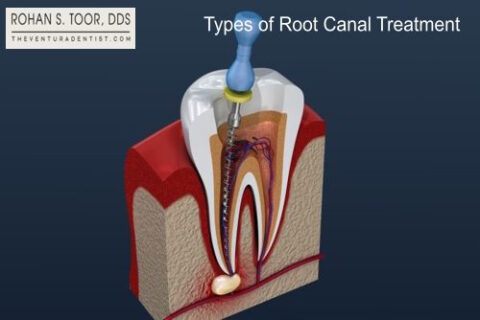
Types of Root Canal Treatment
A root canal treatment repairs and saves an infected or damaged tooth instead of removing it. The most common root canal is a nonsurgical root canal treatment. A dentist will perform a root canal as a last form of treatment before a tooth extraction becomes necessary. Root canals are suggested when there is pain or swelling caused by bacteria that is in the pulp inside of your tooth. Your oral health will be affected and you will be more prone to major health issues if you choose to prolong a root canal treatment. The dentist will remove the infection from inside your tooth during a root canal. After the infection is removed the dentist disinfects the root and places a filling to seal the space. In the next few weeks, the temporary filling is removed and a permanent crown is placed.
Types of Root Canal
The different types of root canal treatments are nonsurgical root canal treatment, apicoectomy, pulpotomy, and pulpectomy. Non-surgical root canal treatment is the most common root canal procedure. The dentist drills down farther than they would during a regular filling to clean the canal. An apicoectomy or endodontic microsurgery is a procedure that requires the removal of a tooth’s root tip and surrounding tissue. A pulpotomy involves the partial removal of the tooth’s pulp, while the roots are able to be left in. A pulpectomy is a procedure that removes the pulp from all parts of the tooth, including the roots.
Non-surgical Root Canal Procedure
A non-surgical root canal procedure is the most common type of root canal. A non-surgical root canal procedure is not painful and similar to getting a really deep filling done. The dentist drills down farther than they would during a regular filling in order to have access to the root canal to clean it.
Apicoectomy Surgery
Apicoectomy is often referred to as a root-end resection because it works on the end or tooth’s root tip. An apicoectomy is also called endodontic microsurgery. An apicoectomy is needed when a standard root canal is ineffective. An apicoectomy is a procedure that requires the removal of a tooth’s root tip and surrounding tissue. The dentist opens the gum tissue near the tooth so that the gum or any infection is revealed. The damaged tissue is removed along with a small amount of the root tip. A root-end filling will be used to fill the area to prevent reinfection of the root.
Pulpotomy and Pulpectomy
A pulpotomy and pulpectomy are both procedures that remove infected pulp tissue. A pulpotomy is a procedure that involves the partial removal of the tooth’s pulp, while the roots are able to be left in. A pulpotomy is a pediatric root canal procedure. The most common material used in pulpotomy is mineral trioxide aggregate, ferric sulfate, and calcium hydroxide. A pulpotomy needs to be done if decay or trauma is confined to the crown of the tooth. A pulpectomy is often performed on children as well. All the infected pulp tissue is completely removed from both the crown and root during a pulpectomy. A pulpectomy should be done if the tissue in both the tooth crown and the tooth root is infected.
Root Canal Retreatment Procedure
A root canal retreatment involves material from the previous treatment being removed. The root canal is cleansed again during retreatment to prevent infection The dentist removes any infection in the tooth and new filling materials will be placed. You will need a root canal retreatment if there is new tooth decay or tooth damage. A root canal retreatment is able to be done two or more times. A root canal retreatment takes 90 minutes.
Waterlase System Laser Dentistry
The WaterLase is a dental laser that does not require your dentist to use a drill or scalpel for your dental care. The WaterLase system uses a water-energized laser beam and is painless. The WaterLase system combines water, air, and laser energy to reduce bacteria and remove decay. Use Waterlase if you want a more comfortable and precise procedure.
Purpose of Different Types of Root Canal Procedures
There are different types of Root Canal infection treatment that cater to your comfortability and oral health. The GentleWave root canal procedure uses fluids and sound waves to remove infected tissue, debris, and bacteria. This method is minimally invasive compared to the typical form of treatment.
The BIOLASE Waterlase system uses light, water, and air to clean out bacteria from the root canals. Endodontic microsurgery is needed if the treatment performed on the root apices of an infected tooth did not work. Root canal retreatment involves removing the previous root canal filling material, cleansing the area, and refilling it with new materials.
What is the Difference Between a Non-surgical Root Canal Treatment and an Apicoectomy?
A non-surgical root canal procedure involves the dentist drilling farther than they normally would during a filling so that there is access to the root canal for cleansing. An apicoectomy involves the dentist removing the tooth’s root tip and filling your root end cavity.
Can a General Dentist Perform Any Type of Root Canal?
Yes, a general dentist can perform any type of root canal. All dentists are trained on how to do a root canal treatment.
Is It Better to Perform Root Canal Retreatment Instead of Tooth Extraction?
Yes, a root canal retreatment is a better way to treat an infected tooth than a tooth extraction. The dentist removes any infection in the tooth and new filling materials will be placed during a root canal retreatment. Tooth extraction is necessary if your tooth is beyond repair or severely decayed.
What more details to know about Root Canal besides it’s types?
Jaw infection treatment with root canal involves removing infected or damaged tissue from the inside of the tooth and replacing it with a filling. It is a common procedure used to save a damaged or infected tooth and alleviate pain or discomfort. At Rohan S. Toor, DDS, we can help you with any questions related to
Root Canal cost with insurance or without it. Top dentist Dr. Rohan Toor at
Rohan S. Toor, DDS is a dentist who specializes in root canal treatment. For Rohan S. Toor, DDS Root Canal, call now
Dr. Rohan Toor looks forward to restoring the health of your teeth.


